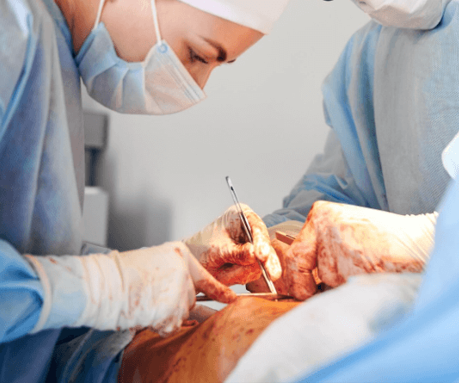Treatment Overview
The Endoscopic-Assisted Endometriosis Surgery (EAES) in Korea is a minimally invasive, precision-guided surgical technique for diagnosing and treating endometriosis. This approach uses advanced endoscopic tools, high-definition imaging, and microsurgical techniques to accurately remove endometriotic lesions while preserving surrounding healthy tissue.
Korea is internationally renowned for integrating state-of-the-art endoscopic technology, robotic assistance, and multidisciplinary care in endometriosis surgery. This makes Korea a top destination for patients seeking safe, effective, and fertility-preserving endometriosis treatment.
Purpose & Benefits
Purpose:
- Accurately diagnose and treat endometriosis
- Remove endometriotic lesions with minimal damage to healthy tissue
- Preserve reproductive and pelvic organ function
- Improve symptom relief and reduce recurrence
Benefits:
- Minimally invasive with small incisions and faster recovery
- High-definition visualization for precision excision
- Less postoperative pain compared to open surgery
- Reduced adhesion formation
- Preservation of fertility and pelvic anatomy
- Shorter hospital stays (often 1–3 days)
- Comprehensive treatment of complex endometriosis cases
Ideal Candidates
EAES is ideal for women who:
- Have confirmed or suspected endometriosis
- Experience chronic pelvic pain, infertility, or menstrual disorders
- Seek fertility-preserving surgery
- Prefer minimally invasive options over open surgery
Korean hospitals conduct detailed preoperative mapping using imaging studies such as ultrasound, MRI, and sometimes diagnostic laparoscopy to tailor the surgery to the patient’s condition.
Possible Risks & Complications
While EAES is safe and advanced, potential risks include:
- Minor bleeding or infection
- Injury to bowel, bladder, ureters, or pelvic nerves
- Adhesion formation
- Recurrence of endometriosis
- Anesthesia-related complications
Korean surgeons reduce these risks through meticulous surgical planning, high-definition imaging, and precision dissection techniques.
Surgical Techniques Used
Korea’s endoscopic-assisted endometriosis surgery combines several advanced methods:
- High-Definition Laparoscopy or Robotic Assistance: For precise lesion mapping and removal.
- Endoscopic Imaging Tools: Provide enhanced visualization of pelvic structures.
- Microsurgical Dissection: Preserves healthy tissue and minimizes trauma.
- Energy-Based Vessel Sealing (Ultrasonic/Bipolar): Reduces bleeding and operative time.
- CO₂ Laser or Plasma Energy: For targeted lesion removal.
- Nerve-Sparing Techniques: Maintain pelvic nerve integrity and function.
These techniques allow surgeons to treat even deep or complex endometriosis cases with minimal invasiveness.
Recovery & Aftercare
Recovery from EAES depends on the extent of disease but is generally faster than open surgery. Most patients are discharged within 1–3 days and resume normal activities within 2–4 weeks.
Postoperative care includes:
- Pain management and incision monitoring
- Pelvic floor physiotherapy for optimal healing
- Avoiding heavy lifting or strenuous activity during recovery
- Follow-up imaging and symptom evaluation
- Hormonal therapy to prevent recurrence
- Fertility counseling if desired
Korean hospitals provide structured postoperative programs to support recovery and reduce recurrence rates.
Results & Longevity
EAES offers long-term benefits, including:
- Effective removal of superficial and deep lesions
- Relief from chronic pelvic pain
- Preservation of fertility and pelvic organ function
- Reduced postoperative complications and adhesions
- Improved quality of life
- Lower recurrence rates when performed by experienced surgeons
Korean hospitals have high success rates due to their expertise in endoscopic-assisted gynecologic surgery.
Treatment Process in Korea
EAES in Korea involves a patient-focused pathway:
- Comprehensive Consultation & Diagnostics: Ultrasound, MRI, and diagnostic laparoscopy if needed.
- Individualized Surgical Planning: Based on lesion mapping, patient needs, and fertility goals.
- Endoscopic-Assisted Surgery: Using high-definition imaging and advanced dissection tools.
- Recovery & Follow-Up: Including physiotherapy, hormonal therapy, and fertility counseling.
International patients benefit from Korea’s medical tourism infrastructure, including concierge support, translation services, and accommodation arrangements.
Cost Range
The Endoscopic-Assisted Endometriosis Surgery in Korea generally ranges between USD 9,500 and 18,000, depending on:
- Complexity of disease
- Use of robotic assistance or advanced imaging
- Hospital and surgeon expertise
- Length of hospital stay and postoperative care
Costs typically include consultation, surgery, anesthesia, hospitalization, and follow-up care.
Popular Clinics
- Samsung Medical Center (Seoul): Expert in high-definition endoscopic-assisted endometriosis surgery.
- Asan Medical Center (Seoul): Offers multidisciplinary endometriosis management.
- Severance Hospital (Yonsei University, Seoul): Specializes in precision laparoscopic and robotic endometriosis surgery.
- CHA Gangnam Medical Center: Known for fertility-preserving endometriosis surgery with endoscopic assistance.
- Ewha Womans University Medical Center: Integrates endoscopic-assisted surgery with comprehensive recovery programs.




